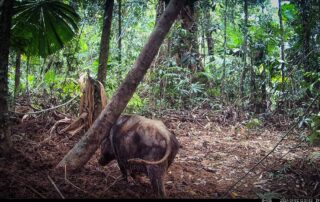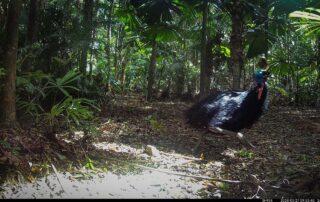Camera Traps – January 2024 accrued 108-cassowaries, 50-dingoes and 182-feral pigs. Against the cumulative monthly average, cassowary numbers fell by 1%, dingoes increased by 24% and feral-pig numbers grew by 57%. Against January 2023, cassowaries were 66%-down, dingoes were 47% down and feral-pig soared by 230%.
Image highlights from January
The last footage of Manu, together with Leo & Mikey
The last footage of Prudy
Prudy took the grand cassowary matriarch role upon Big Bertha’s retirement and relocation into non-competing territory. Quite concerningly, we have not sighted Prudy since Cyclone Jasper on 13th December 2023. Both Crinkle Cut’s and Taiga’s two remaining chicks, Tulli & TK & Larry & Curley (respectively), were lost to the same cyclone and its ensuing deluge and landslides. Whilst little chicks are far more vulnerable to the devastation of flooding, a big adult bird like Prudy is not immune to a multitude of possible dangers.
Feral-pigs dredging for earthworms
Feral-pigs have been described foraging for food through dredging in two six-hour-blocks per day, generally beginning around 4-AM through to 10-AM-ish, whereupon they revert to wallowing for around six-hours until foraging again from 4-PM-ish to around 10-PM, when they retire for six-or-so-hours of sleep. So, 12-hours of dredging per-pig per-day, multiplied by perhaps as many as 24-million feral-pigs, aggregates to a colossal degradation across Australia’s terrestrial landscape.
In the Wet Tropics World Heritage Rainforest, an estimated 30,000 feral-pigs dredge away through a root-structure that evolved to keep rainforest product within a closed system for re-cycling. Not only does this aggregating feral-pig degradation rob the second-most irreplaceable World Heritage property on the planet of its productivity, it also weakens the structural integrity of the entire assemblage, compounding the structural damage suffered through the deluge brought about by Cyclone Jasper.
The growing threat of uncharitable ‘charities’
Last year, the ACNC introduced Governance Standard 5, requiring charities to take reasonable steps to make sure directors comply with the following duties:
- to act with reasonable care and diligence
- to act honestly and fairly in the best interests of the charity and for its charitable purposes
- not to misuse their position or information they gain as a Responsible Person
- to disclose conflicts of interest
- to ensure that the financial affairs of the charity are managed responsibly, and
- not to allow the charity to operate while it is insolvent.
Generally, the duties mean that Responsible People should act with standards of integrity and common sense.
Under Article 17 of the World Heritage Convention, Australia is encouraged as a State Party to establish national, public and private foundations, whose purpose is to invite donations for the protection of the cultural and natural heritage values of inscribed World Heritage Areas.
Over the past 20-years-or-so, several foundations have expended large quantities of donated money into property acquisition from Daintree Rainforest community lands. Whilst such foundations may have gained support from the encouraging nature of Article 17, the uncharitable attrition of community lands and the denigration of rainforest residency as a fund-raising strategy, flies in the face of Article 5 of the World Heritage Convention, which requires effective and active protection, conservation and presentation of the World Heritage values, as the central function in the life of the custodial community.
Whilst there is no disputing the conservation importance of the natural and cultural heritage values found almost exclusively north of the Daintree River to Cape Tribulation and surrounds, the only property that can be acquired for the management entitlements of any speculative environmental foundation, is property that is currently owned by members of the custodial communities within this targeted area. It is the purpose of the Statutory Planning Scheme within the Daintree River – Bloomfield River local plan, to retain the attraction of the area as a very low-key, largely undeveloped nature-based recreation environment, based on the exploration and appreciation of the natural environment and to ensure that any development that does occur is appropriate and does not place additional pressures on the values of area. The custodial community’s capacity to achieve this purpose, to the highest possible extent, is dependent upon the judicious management of community assets and the community’s greatest asset is its lands and the people that have a care for them. The systematic acquisition of these primary assets by foundations thousands of kilometres away, fragments community with absentee landlords.
How can the governance standard of acting honestly and fairly in the best interests of the charity and for its charitable purposes, justify the denigration of a custodial community, as a call-to-action to ‘Save the Daintree Rainforest’, when the outcome depletes the custodial community of its conservation assets and weakens custodial potential?
Also, the governance standard that requires reasonable care and diligence, should properly acknowledge the targeted lands’ formal state of regulatory security:
As the vast majority of the Daintree Rainforest is World Heritage-listed and as of 26th November 2021, the entire Daintree lowland rainforest, including all lands outside of the World Heritage Area, was listed in the Endangered category of the threatened ecological communities list under the Environment Protection and Biodiversity Conservation Act 1999 (Cwlth) (EPBC Act), all property north of the Daintree River to Cape Tribulation is protected under federal environmental regulation, as a Matters of National Environmental Significance. Targeting these properties for urgent acquisition under the misleading call-to-action that development can occur upon any of these properties subject only to local government approval, fails to acknowledge the federal Endangered Community declaration, which contradicts the environmental risk and urgency.
Daintree Rainforest Foundation Ltd has been registered by the Australian Charities and Not-for-profits Commission and successfully entered onto the Register of Environmental Organisations. Donations made to the Daintree Rainforest Fund support the Daintree Rainforest community custodianship and are eligible for a tax deduction under the Income Tax Assessment Act 1997.


















